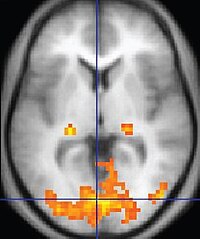
Photo from wikipedia
The brain is organized into distinct, flexible networks. Within these networks, cognitive variables such as attention can modulate sensory representations in accordance with moment-to-moment behavioral requirements. These modulations can be… Click to show full abstract
The brain is organized into distinct, flexible networks. Within these networks, cognitive variables such as attention can modulate sensory representations in accordance with moment-to-moment behavioral requirements. These modulations can be studied by varying task demands; however, the tasks employed are often incongruent with the postulated functions of a sensory system, limiting the characterization of the system in relation to natural behaviors. Here we combine domain-specific task manipulations and ultra-high field fMRI to study the nature of top-down modulations. We exploited faces, a visual category underpinned by a complex cortical network, and instructed participants to perform either a stimulus-relevant/domain-specific or a stimulus-irrelevant task in the scanner. We found that 1. perceptual ambiguity (i.e. difficulty of achieving a stable percept) is encoded in top-down modulations from higher-level cortices; 2. the right inferior-temporal lobe is active under challenging conditions and uniquely encodes trial-by-trial variability in face perception.
Journal Title: NeuroImage
Year Published: 2021
Link to full text (if available)
Share on Social Media: Sign Up to like & get
recommendations!